Organisational Behaviour Report: M&S, Motivation, and Performance
VerifiedAdded on 2022/12/27
|17
|5438
|1
Report
AI Summary
This report examines organisational behaviour within Mark & Spencer, exploring how culture, politics, and power influence individual and team dynamics. It analyzes the impact of power structures (coercive, reward, legitimate, expert, referent, and informational) and political factors on employee productivity and attitudes. The report also applies Handy's culture typology to understand cultural influences. Furthermore, it evaluates content theories of motivation, including Herzberg's two-factor theory and Maslow's hierarchy of needs, to assess their role in achieving organisational goals. The report also discusses the effectiveness of various motivational techniques. The report then critically analyses how organisational elements affect individual and team behaviour and performance. It concludes by assessing the relationship between content and process theories of motivation and their impact on goal achievement within the organisation.
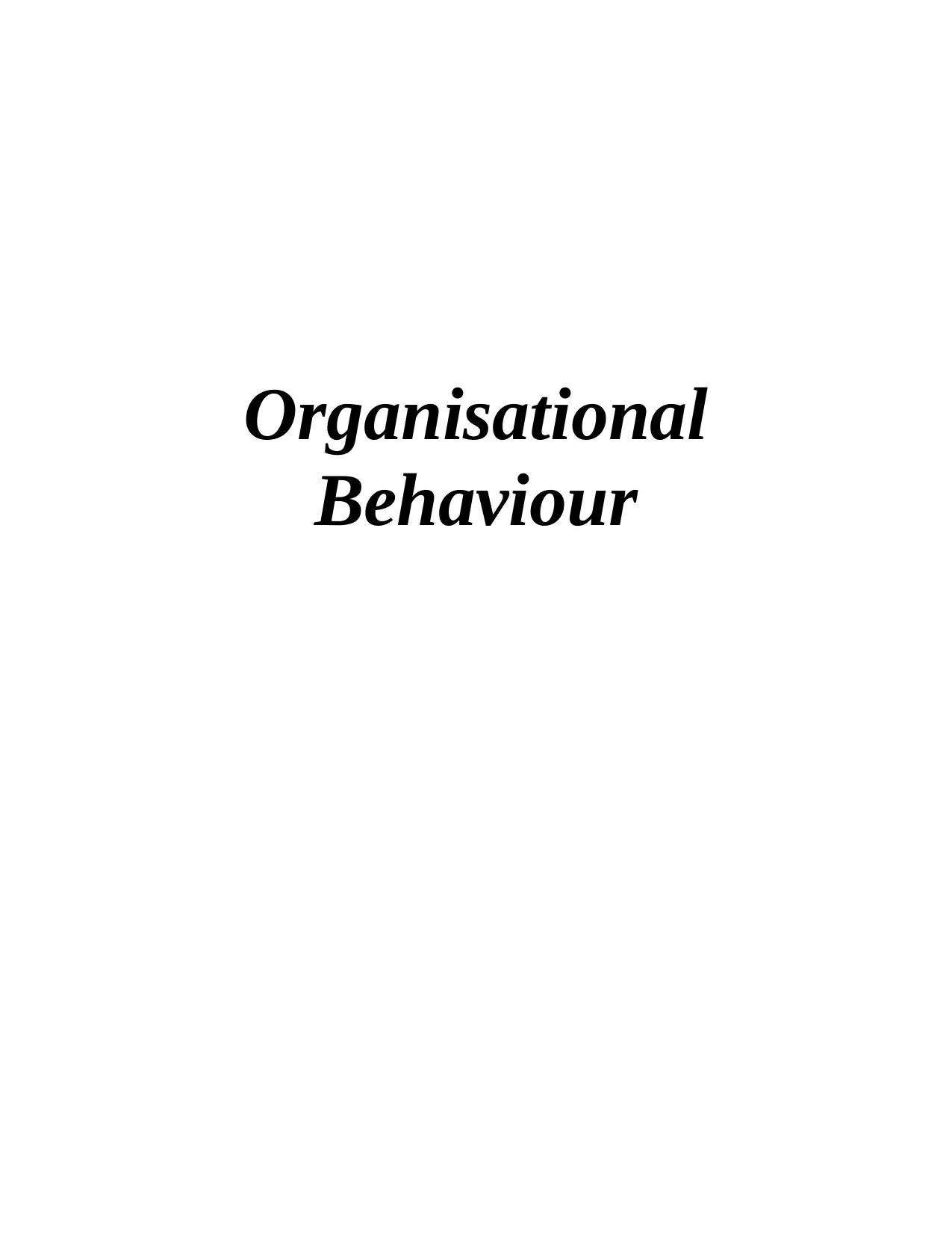
Organisational
Behaviour
Behaviour
Paraphrase This Document
Need a fresh take? Get an instant paraphrase of this document with our AI Paraphraser
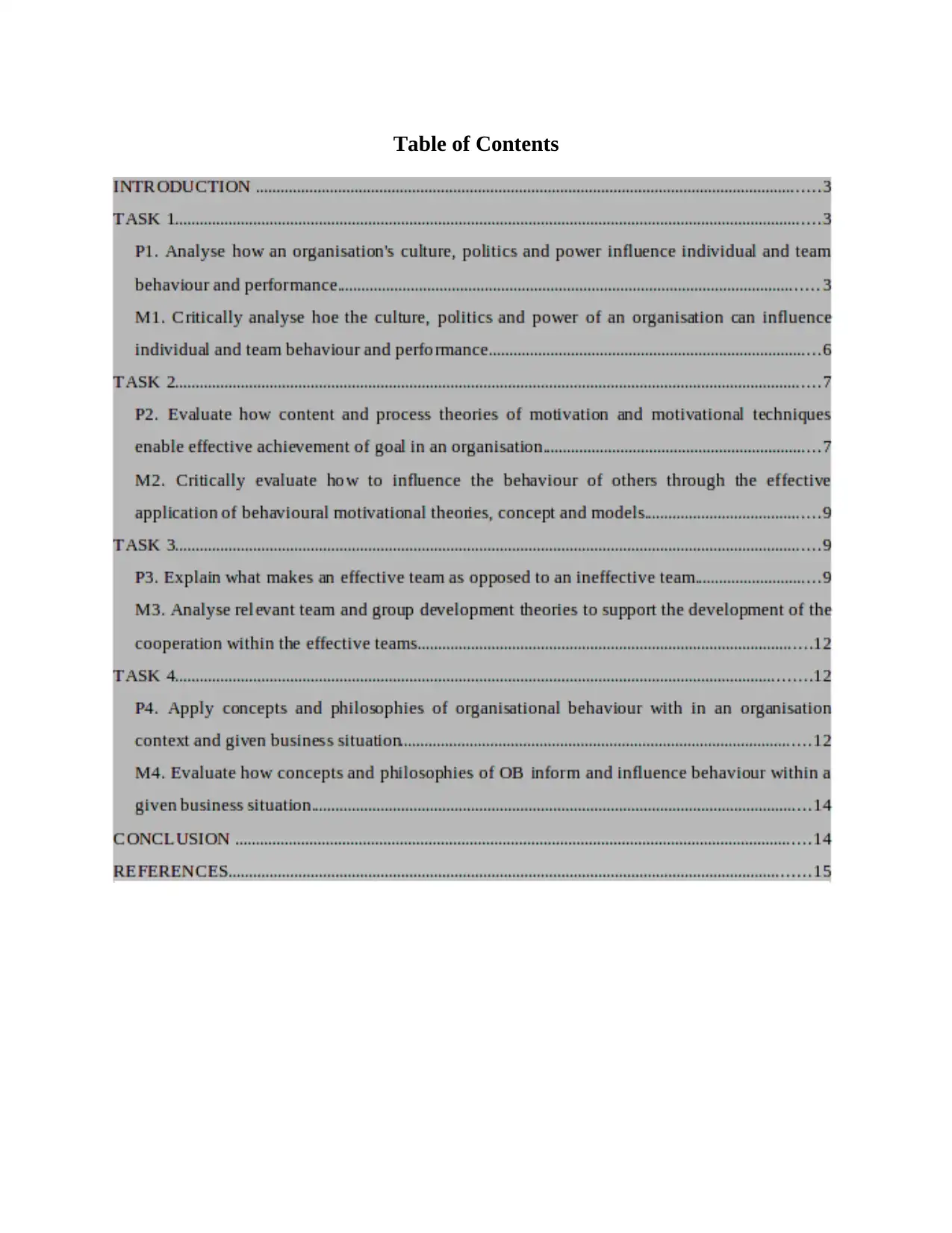
Table of Contents
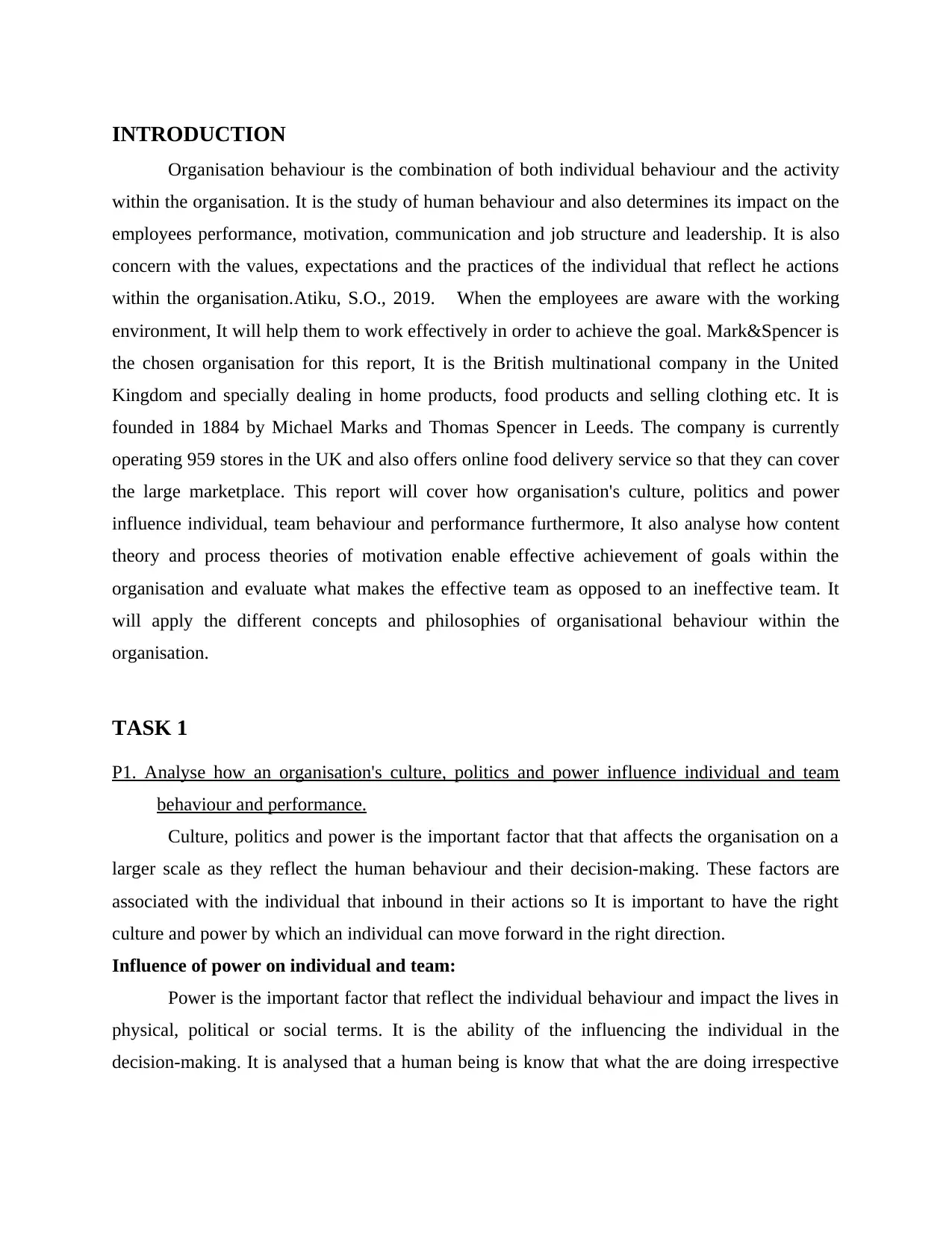
INTRODUCTION
Organisation behaviour is the combination of both individual behaviour and the activity
within the organisation. It is the study of human behaviour and also determines its impact on the
employees performance, motivation, communication and job structure and leadership. It is also
concern with the values, expectations and the practices of the individual that reflect he actions
within the organisation.Atiku, S.O., 2019. When the employees are aware with the working
environment, It will help them to work effectively in order to achieve the goal. Mark&Spencer is
the chosen organisation for this report, It is the British multinational company in the United
Kingdom and specially dealing in home products, food products and selling clothing etc. It is
founded in 1884 by Michael Marks and Thomas Spencer in Leeds. The company is currently
operating 959 stores in the UK and also offers online food delivery service so that they can cover
the large marketplace. This report will cover how organisation's culture, politics and power
influence individual, team behaviour and performance furthermore, It also analyse how content
theory and process theories of motivation enable effective achievement of goals within the
organisation and evaluate what makes the effective team as opposed to an ineffective team. It
will apply the different concepts and philosophies of organisational behaviour within the
organisation.
TASK 1
P1. Analyse how an organisation's culture, politics and power influence individual and team
behaviour and performance.
Culture, politics and power is the important factor that that affects the organisation on a
larger scale as they reflect the human behaviour and their decision-making. These factors are
associated with the individual that inbound in their actions so It is important to have the right
culture and power by which an individual can move forward in the right direction.
Influence of power on individual and team:
Power is the important factor that reflect the individual behaviour and impact the lives in
physical, political or social terms. It is the ability of the influencing the individual in the
decision-making. It is analysed that a human being is know that what the are doing irrespective
Organisation behaviour is the combination of both individual behaviour and the activity
within the organisation. It is the study of human behaviour and also determines its impact on the
employees performance, motivation, communication and job structure and leadership. It is also
concern with the values, expectations and the practices of the individual that reflect he actions
within the organisation.Atiku, S.O., 2019. When the employees are aware with the working
environment, It will help them to work effectively in order to achieve the goal. Mark&Spencer is
the chosen organisation for this report, It is the British multinational company in the United
Kingdom and specially dealing in home products, food products and selling clothing etc. It is
founded in 1884 by Michael Marks and Thomas Spencer in Leeds. The company is currently
operating 959 stores in the UK and also offers online food delivery service so that they can cover
the large marketplace. This report will cover how organisation's culture, politics and power
influence individual, team behaviour and performance furthermore, It also analyse how content
theory and process theories of motivation enable effective achievement of goals within the
organisation and evaluate what makes the effective team as opposed to an ineffective team. It
will apply the different concepts and philosophies of organisational behaviour within the
organisation.
TASK 1
P1. Analyse how an organisation's culture, politics and power influence individual and team
behaviour and performance.
Culture, politics and power is the important factor that that affects the organisation on a
larger scale as they reflect the human behaviour and their decision-making. These factors are
associated with the individual that inbound in their actions so It is important to have the right
culture and power by which an individual can move forward in the right direction.
Influence of power on individual and team:
Power is the important factor that reflect the individual behaviour and impact the lives in
physical, political or social terms. It is the ability of the influencing the individual in the
decision-making. It is analysed that a human being is know that what the are doing irrespective
⊘ This is a preview!⊘
Do you want full access?
Subscribe today to unlock all pages.

Trusted by 1+ million students worldwide
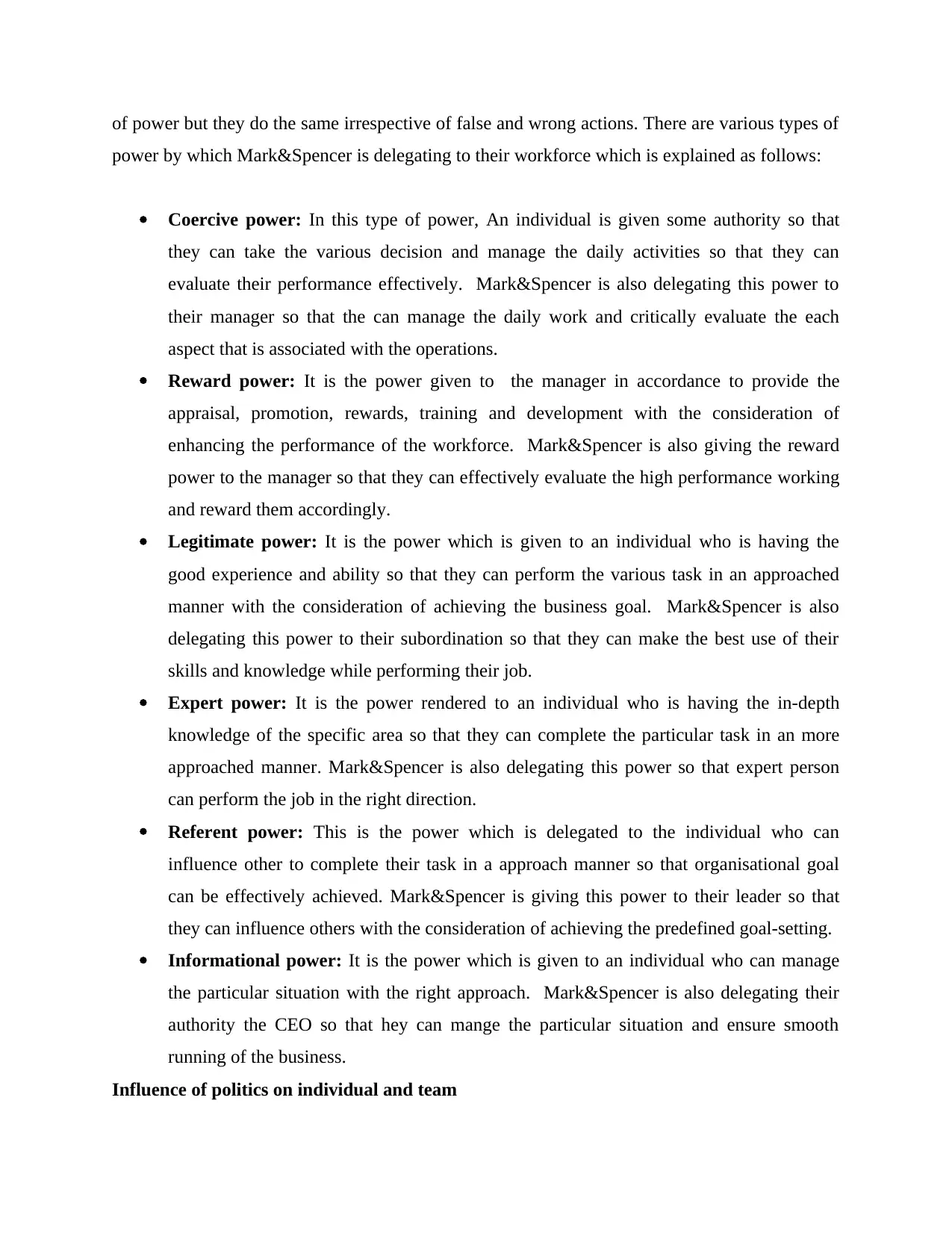
of power but they do the same irrespective of false and wrong actions. There are various types of
power by which Mark&Spencer is delegating to their workforce which is explained as follows:
Coercive power: In this type of power, An individual is given some authority so that
they can take the various decision and manage the daily activities so that they can
evaluate their performance effectively. Mark&Spencer is also delegating this power to
their manager so that the can manage the daily work and critically evaluate the each
aspect that is associated with the operations.
Reward power: It is the power given to the manager in accordance to provide the
appraisal, promotion, rewards, training and development with the consideration of
enhancing the performance of the workforce. Mark&Spencer is also giving the reward
power to the manager so that they can effectively evaluate the high performance working
and reward them accordingly.
Legitimate power: It is the power which is given to an individual who is having the
good experience and ability so that they can perform the various task in an approached
manner with the consideration of achieving the business goal. Mark&Spencer is also
delegating this power to their subordination so that they can make the best use of their
skills and knowledge while performing their job.
Expert power: It is the power rendered to an individual who is having the in-depth
knowledge of the specific area so that they can complete the particular task in an more
approached manner. Mark&Spencer is also delegating this power so that expert person
can perform the job in the right direction.
Referent power: This is the power which is delegated to the individual who can
influence other to complete their task in a approach manner so that organisational goal
can be effectively achieved. Mark&Spencer is giving this power to their leader so that
they can influence others with the consideration of achieving the predefined goal-setting.
Informational power: It is the power which is given to an individual who can manage
the particular situation with the right approach. Mark&Spencer is also delegating their
authority the CEO so that hey can mange the particular situation and ensure smooth
running of the business.
Influence of politics on individual and team
power by which Mark&Spencer is delegating to their workforce which is explained as follows:
Coercive power: In this type of power, An individual is given some authority so that
they can take the various decision and manage the daily activities so that they can
evaluate their performance effectively. Mark&Spencer is also delegating this power to
their manager so that the can manage the daily work and critically evaluate the each
aspect that is associated with the operations.
Reward power: It is the power given to the manager in accordance to provide the
appraisal, promotion, rewards, training and development with the consideration of
enhancing the performance of the workforce. Mark&Spencer is also giving the reward
power to the manager so that they can effectively evaluate the high performance working
and reward them accordingly.
Legitimate power: It is the power which is given to an individual who is having the
good experience and ability so that they can perform the various task in an approached
manner with the consideration of achieving the business goal. Mark&Spencer is also
delegating this power to their subordination so that they can make the best use of their
skills and knowledge while performing their job.
Expert power: It is the power rendered to an individual who is having the in-depth
knowledge of the specific area so that they can complete the particular task in an more
approached manner. Mark&Spencer is also delegating this power so that expert person
can perform the job in the right direction.
Referent power: This is the power which is delegated to the individual who can
influence other to complete their task in a approach manner so that organisational goal
can be effectively achieved. Mark&Spencer is giving this power to their leader so that
they can influence others with the consideration of achieving the predefined goal-setting.
Informational power: It is the power which is given to an individual who can manage
the particular situation with the right approach. Mark&Spencer is also delegating their
authority the CEO so that hey can mange the particular situation and ensure smooth
running of the business.
Influence of politics on individual and team
Paraphrase This Document
Need a fresh take? Get an instant paraphrase of this document with our AI Paraphraser
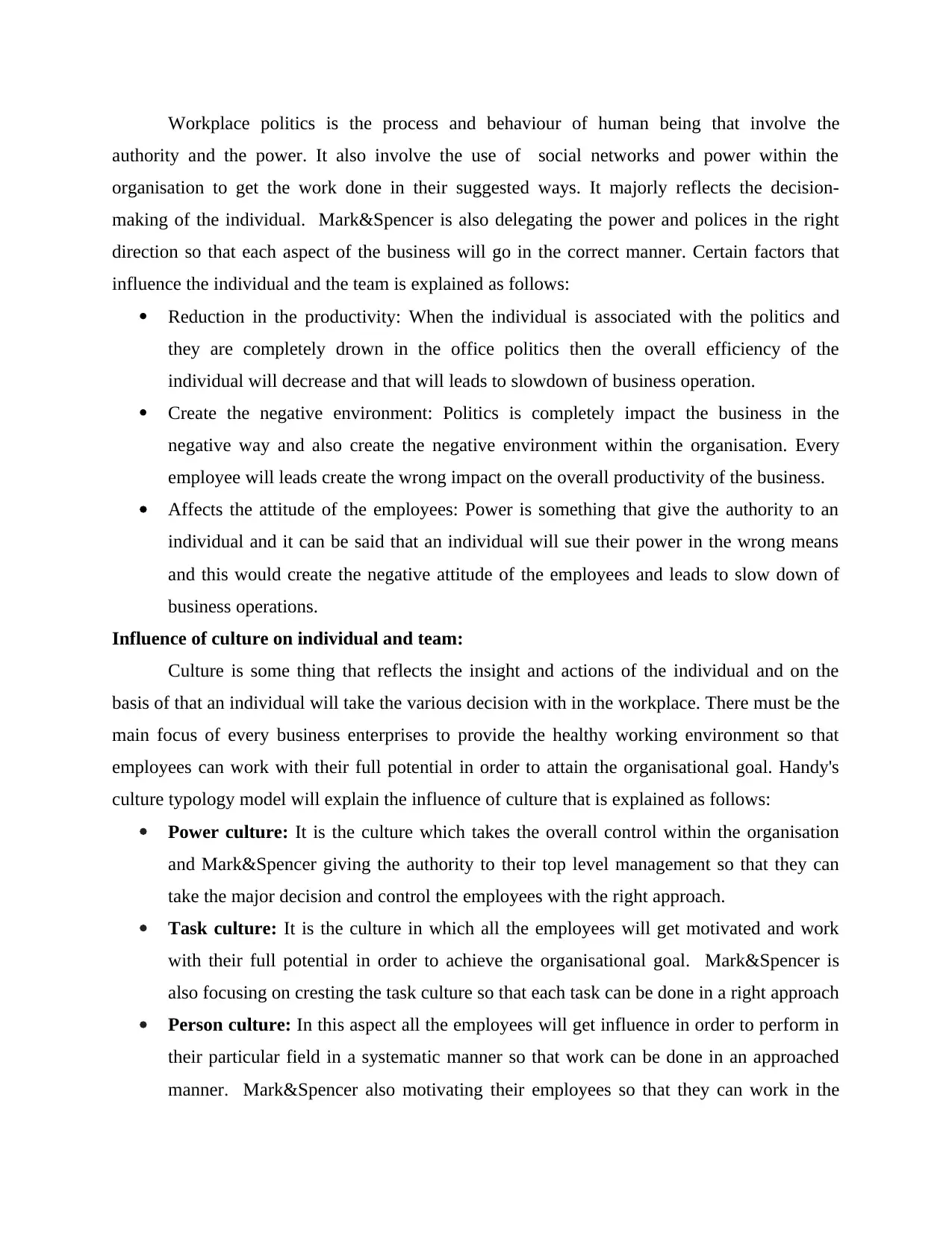
Workplace politics is the process and behaviour of human being that involve the
authority and the power. It also involve the use of social networks and power within the
organisation to get the work done in their suggested ways. It majorly reflects the decision-
making of the individual. Mark&Spencer is also delegating the power and polices in the right
direction so that each aspect of the business will go in the correct manner. Certain factors that
influence the individual and the team is explained as follows:
Reduction in the productivity: When the individual is associated with the politics and
they are completely drown in the office politics then the overall efficiency of the
individual will decrease and that will leads to slowdown of business operation.
Create the negative environment: Politics is completely impact the business in the
negative way and also create the negative environment within the organisation. Every
employee will leads create the wrong impact on the overall productivity of the business.
Affects the attitude of the employees: Power is something that give the authority to an
individual and it can be said that an individual will sue their power in the wrong means
and this would create the negative attitude of the employees and leads to slow down of
business operations.
Influence of culture on individual and team:
Culture is some thing that reflects the insight and actions of the individual and on the
basis of that an individual will take the various decision with in the workplace. There must be the
main focus of every business enterprises to provide the healthy working environment so that
employees can work with their full potential in order to attain the organisational goal. Handy's
culture typology model will explain the influence of culture that is explained as follows:
Power culture: It is the culture which takes the overall control within the organisation
and Mark&Spencer giving the authority to their top level management so that they can
take the major decision and control the employees with the right approach.
Task culture: It is the culture in which all the employees will get motivated and work
with their full potential in order to achieve the organisational goal. Mark&Spencer is
also focusing on cresting the task culture so that each task can be done in a right approach
Person culture: In this aspect all the employees will get influence in order to perform in
their particular field in a systematic manner so that work can be done in an approached
manner. Mark&Spencer also motivating their employees so that they can work in the
authority and the power. It also involve the use of social networks and power within the
organisation to get the work done in their suggested ways. It majorly reflects the decision-
making of the individual. Mark&Spencer is also delegating the power and polices in the right
direction so that each aspect of the business will go in the correct manner. Certain factors that
influence the individual and the team is explained as follows:
Reduction in the productivity: When the individual is associated with the politics and
they are completely drown in the office politics then the overall efficiency of the
individual will decrease and that will leads to slowdown of business operation.
Create the negative environment: Politics is completely impact the business in the
negative way and also create the negative environment within the organisation. Every
employee will leads create the wrong impact on the overall productivity of the business.
Affects the attitude of the employees: Power is something that give the authority to an
individual and it can be said that an individual will sue their power in the wrong means
and this would create the negative attitude of the employees and leads to slow down of
business operations.
Influence of culture on individual and team:
Culture is some thing that reflects the insight and actions of the individual and on the
basis of that an individual will take the various decision with in the workplace. There must be the
main focus of every business enterprises to provide the healthy working environment so that
employees can work with their full potential in order to attain the organisational goal. Handy's
culture typology model will explain the influence of culture that is explained as follows:
Power culture: It is the culture which takes the overall control within the organisation
and Mark&Spencer giving the authority to their top level management so that they can
take the major decision and control the employees with the right approach.
Task culture: It is the culture in which all the employees will get motivated and work
with their full potential in order to achieve the organisational goal. Mark&Spencer is
also focusing on cresting the task culture so that each task can be done in a right approach
Person culture: In this aspect all the employees will get influence in order to perform in
their particular field in a systematic manner so that work can be done in an approached
manner. Mark&Spencer also motivating their employees so that they can work in the
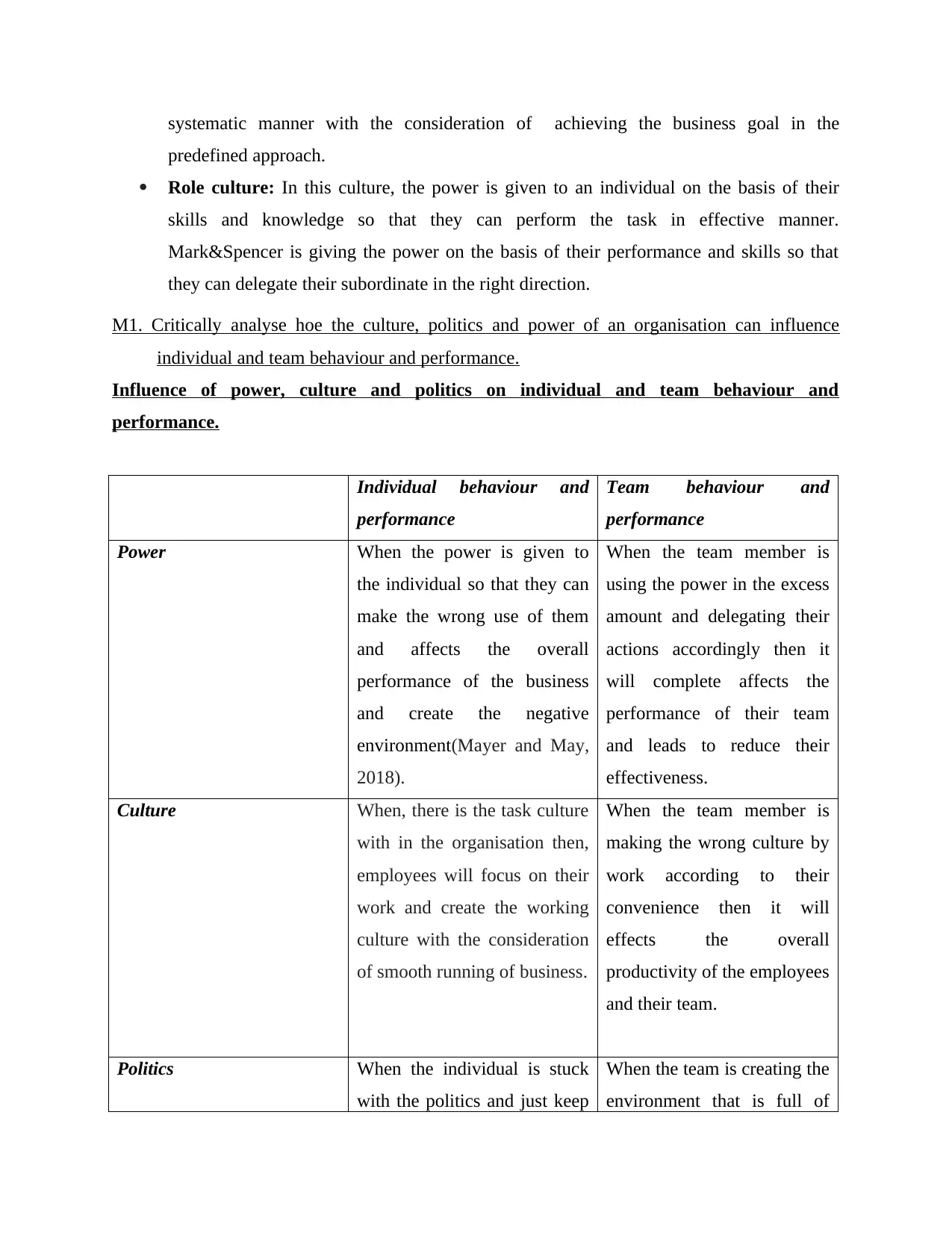
systematic manner with the consideration of achieving the business goal in the
predefined approach.
Role culture: In this culture, the power is given to an individual on the basis of their
skills and knowledge so that they can perform the task in effective manner.
Mark&Spencer is giving the power on the basis of their performance and skills so that
they can delegate their subordinate in the right direction.
M1. Critically analyse hoe the culture, politics and power of an organisation can influence
individual and team behaviour and performance.
Influence of power, culture and politics on individual and team behaviour and
performance.
Individual behaviour and
performance
Team behaviour and
performance
Power When the power is given to
the individual so that they can
make the wrong use of them
and affects the overall
performance of the business
and create the negative
environment(Mayer and May,
2018).
When the team member is
using the power in the excess
amount and delegating their
actions accordingly then it
will complete affects the
performance of their team
and leads to reduce their
effectiveness.
Culture When, there is the task culture
with in the organisation then,
employees will focus on their
work and create the working
culture with the consideration
of smooth running of business.
When the team member is
making the wrong culture by
work according to their
convenience then it will
effects the overall
productivity of the employees
and their team.
Politics When the individual is stuck
with the politics and just keep
When the team is creating the
environment that is full of
predefined approach.
Role culture: In this culture, the power is given to an individual on the basis of their
skills and knowledge so that they can perform the task in effective manner.
Mark&Spencer is giving the power on the basis of their performance and skills so that
they can delegate their subordinate in the right direction.
M1. Critically analyse hoe the culture, politics and power of an organisation can influence
individual and team behaviour and performance.
Influence of power, culture and politics on individual and team behaviour and
performance.
Individual behaviour and
performance
Team behaviour and
performance
Power When the power is given to
the individual so that they can
make the wrong use of them
and affects the overall
performance of the business
and create the negative
environment(Mayer and May,
2018).
When the team member is
using the power in the excess
amount and delegating their
actions accordingly then it
will complete affects the
performance of their team
and leads to reduce their
effectiveness.
Culture When, there is the task culture
with in the organisation then,
employees will focus on their
work and create the working
culture with the consideration
of smooth running of business.
When the team member is
making the wrong culture by
work according to their
convenience then it will
effects the overall
productivity of the employees
and their team.
Politics When the individual is stuck
with the politics and just keep
When the team is creating the
environment that is full of
⊘ This is a preview!⊘
Do you want full access?
Subscribe today to unlock all pages.

Trusted by 1+ million students worldwide
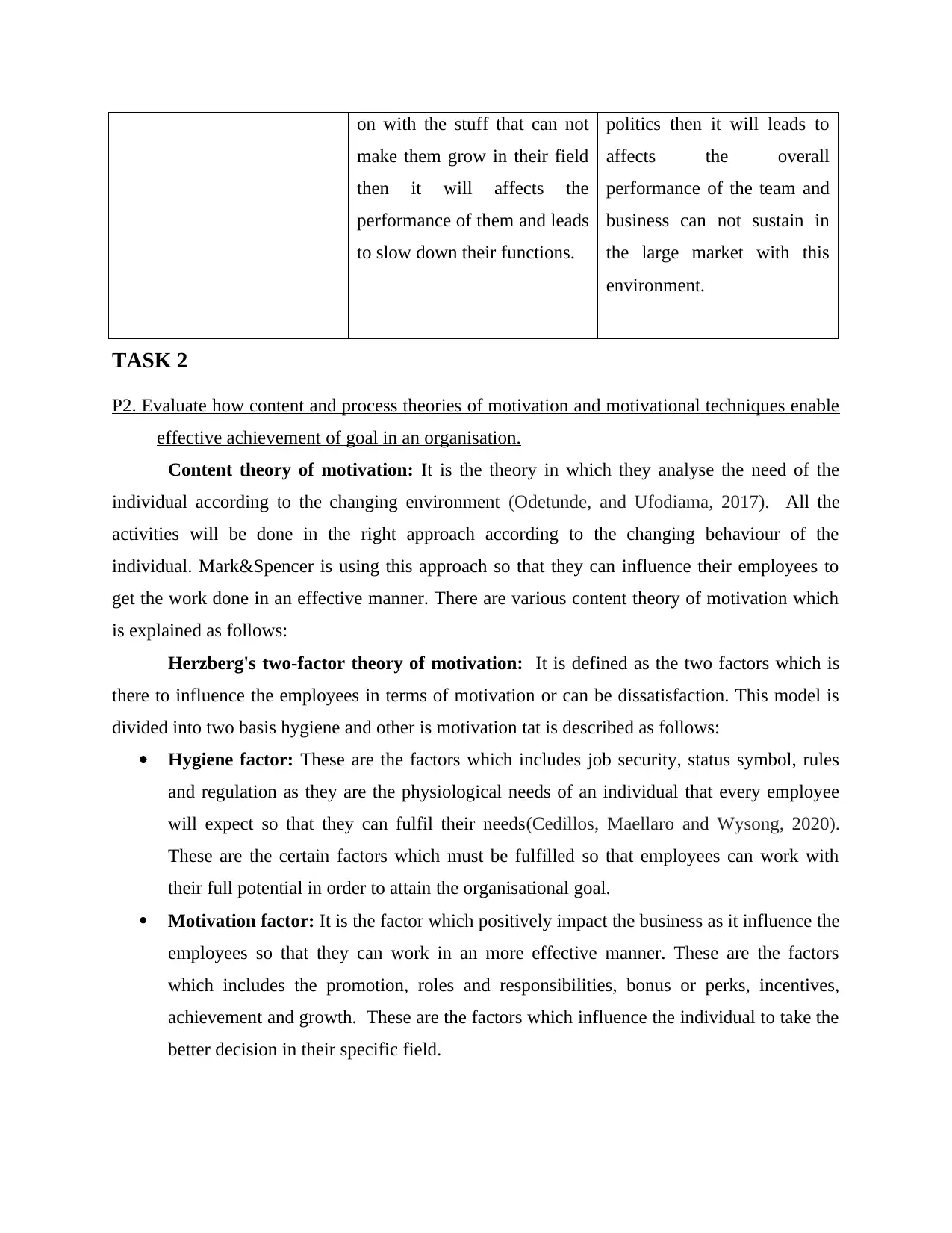
on with the stuff that can not
make them grow in their field
then it will affects the
performance of them and leads
to slow down their functions.
politics then it will leads to
affects the overall
performance of the team and
business can not sustain in
the large market with this
environment.
TASK 2
P2. Evaluate how content and process theories of motivation and motivational techniques enable
effective achievement of goal in an organisation.
Content theory of motivation: It is the theory in which they analyse the need of the
individual according to the changing environment (Odetunde, and Ufodiama, 2017). All the
activities will be done in the right approach according to the changing behaviour of the
individual. Mark&Spencer is using this approach so that they can influence their employees to
get the work done in an effective manner. There are various content theory of motivation which
is explained as follows:
Herzberg's two-factor theory of motivation: It is defined as the two factors which is
there to influence the employees in terms of motivation or can be dissatisfaction. This model is
divided into two basis hygiene and other is motivation tat is described as follows:
Hygiene factor: These are the factors which includes job security, status symbol, rules
and regulation as they are the physiological needs of an individual that every employee
will expect so that they can fulfil their needs(Cedillos, Maellaro and Wysong, 2020).
These are the certain factors which must be fulfilled so that employees can work with
their full potential in order to attain the organisational goal.
Motivation factor: It is the factor which positively impact the business as it influence the
employees so that they can work in an more effective manner. These are the factors
which includes the promotion, roles and responsibilities, bonus or perks, incentives,
achievement and growth. These are the factors which influence the individual to take the
better decision in their specific field.
make them grow in their field
then it will affects the
performance of them and leads
to slow down their functions.
politics then it will leads to
affects the overall
performance of the team and
business can not sustain in
the large market with this
environment.
TASK 2
P2. Evaluate how content and process theories of motivation and motivational techniques enable
effective achievement of goal in an organisation.
Content theory of motivation: It is the theory in which they analyse the need of the
individual according to the changing environment (Odetunde, and Ufodiama, 2017). All the
activities will be done in the right approach according to the changing behaviour of the
individual. Mark&Spencer is using this approach so that they can influence their employees to
get the work done in an effective manner. There are various content theory of motivation which
is explained as follows:
Herzberg's two-factor theory of motivation: It is defined as the two factors which is
there to influence the employees in terms of motivation or can be dissatisfaction. This model is
divided into two basis hygiene and other is motivation tat is described as follows:
Hygiene factor: These are the factors which includes job security, status symbol, rules
and regulation as they are the physiological needs of an individual that every employee
will expect so that they can fulfil their needs(Cedillos, Maellaro and Wysong, 2020).
These are the certain factors which must be fulfilled so that employees can work with
their full potential in order to attain the organisational goal.
Motivation factor: It is the factor which positively impact the business as it influence the
employees so that they can work in an more effective manner. These are the factors
which includes the promotion, roles and responsibilities, bonus or perks, incentives,
achievement and growth. These are the factors which influence the individual to take the
better decision in their specific field.
Paraphrase This Document
Need a fresh take? Get an instant paraphrase of this document with our AI Paraphraser
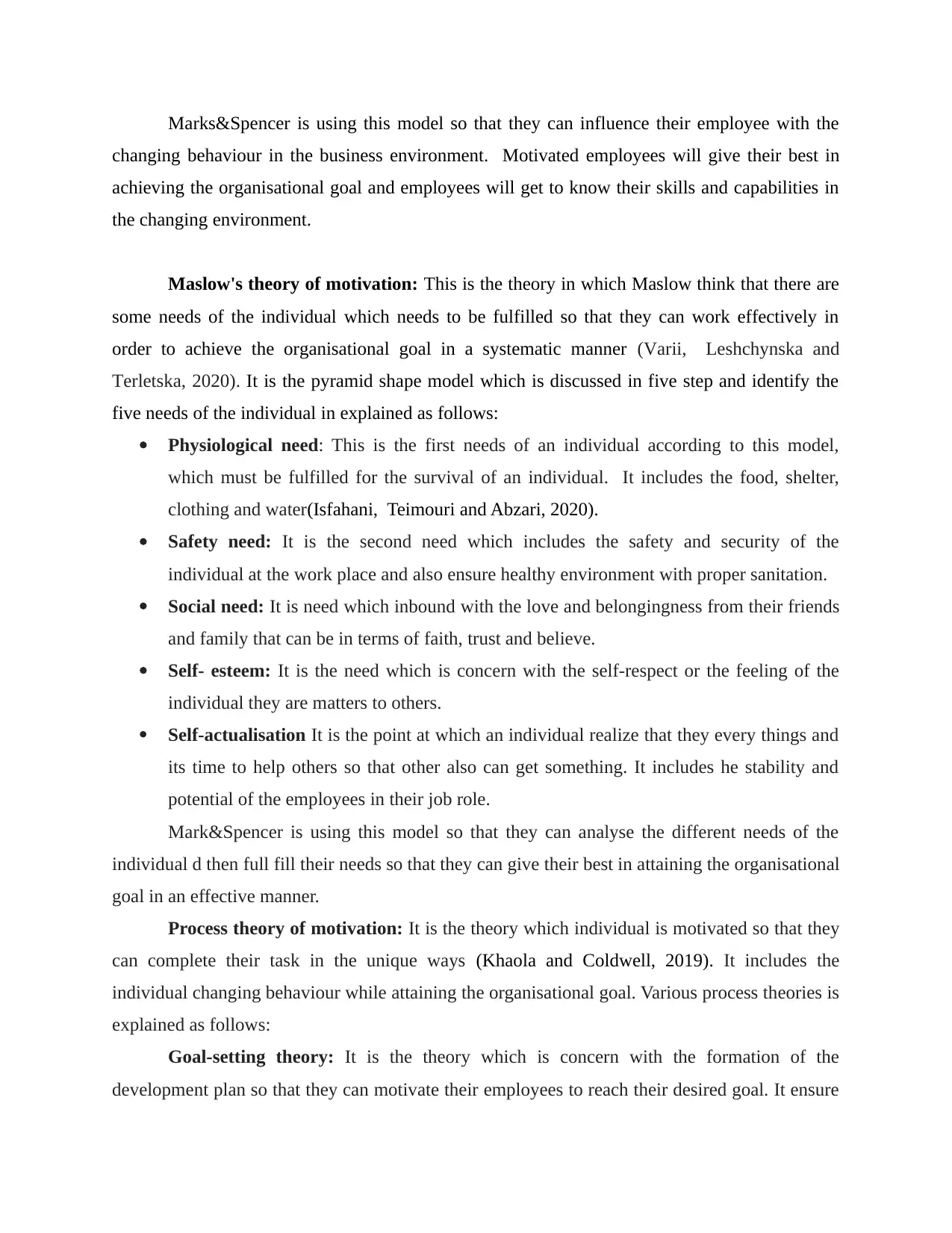
Marks&Spencer is using this model so that they can influence their employee with the
changing behaviour in the business environment. Motivated employees will give their best in
achieving the organisational goal and employees will get to know their skills and capabilities in
the changing environment.
Maslow's theory of motivation: This is the theory in which Maslow think that there are
some needs of the individual which needs to be fulfilled so that they can work effectively in
order to achieve the organisational goal in a systematic manner (Varii, Leshchynska and
Terletska, 2020). It is the pyramid shape model which is discussed in five step and identify the
five needs of the individual in explained as follows:
Physiological need: This is the first needs of an individual according to this model,
which must be fulfilled for the survival of an individual. It includes the food, shelter,
clothing and water(Isfahani, Teimouri and Abzari, 2020).
Safety need: It is the second need which includes the safety and security of the
individual at the work place and also ensure healthy environment with proper sanitation.
Social need: It is need which inbound with the love and belongingness from their friends
and family that can be in terms of faith, trust and believe.
Self- esteem: It is the need which is concern with the self-respect or the feeling of the
individual they are matters to others.
Self-actualisation It is the point at which an individual realize that they every things and
its time to help others so that other also can get something. It includes he stability and
potential of the employees in their job role.
Mark&Spencer is using this model so that they can analyse the different needs of the
individual d then full fill their needs so that they can give their best in attaining the organisational
goal in an effective manner.
Process theory of motivation: It is the theory which individual is motivated so that they
can complete their task in the unique ways (Khaola and Coldwell, 2019). It includes the
individual changing behaviour while attaining the organisational goal. Various process theories is
explained as follows:
Goal-setting theory: It is the theory which is concern with the formation of the
development plan so that they can motivate their employees to reach their desired goal. It ensure
changing behaviour in the business environment. Motivated employees will give their best in
achieving the organisational goal and employees will get to know their skills and capabilities in
the changing environment.
Maslow's theory of motivation: This is the theory in which Maslow think that there are
some needs of the individual which needs to be fulfilled so that they can work effectively in
order to achieve the organisational goal in a systematic manner (Varii, Leshchynska and
Terletska, 2020). It is the pyramid shape model which is discussed in five step and identify the
five needs of the individual in explained as follows:
Physiological need: This is the first needs of an individual according to this model,
which must be fulfilled for the survival of an individual. It includes the food, shelter,
clothing and water(Isfahani, Teimouri and Abzari, 2020).
Safety need: It is the second need which includes the safety and security of the
individual at the work place and also ensure healthy environment with proper sanitation.
Social need: It is need which inbound with the love and belongingness from their friends
and family that can be in terms of faith, trust and believe.
Self- esteem: It is the need which is concern with the self-respect or the feeling of the
individual they are matters to others.
Self-actualisation It is the point at which an individual realize that they every things and
its time to help others so that other also can get something. It includes he stability and
potential of the employees in their job role.
Mark&Spencer is using this model so that they can analyse the different needs of the
individual d then full fill their needs so that they can give their best in attaining the organisational
goal in an effective manner.
Process theory of motivation: It is the theory which individual is motivated so that they
can complete their task in the unique ways (Khaola and Coldwell, 2019). It includes the
individual changing behaviour while attaining the organisational goal. Various process theories is
explained as follows:
Goal-setting theory: It is the theory which is concern with the formation of the
development plan so that they can motivate their employees to reach their desired goal. It ensure
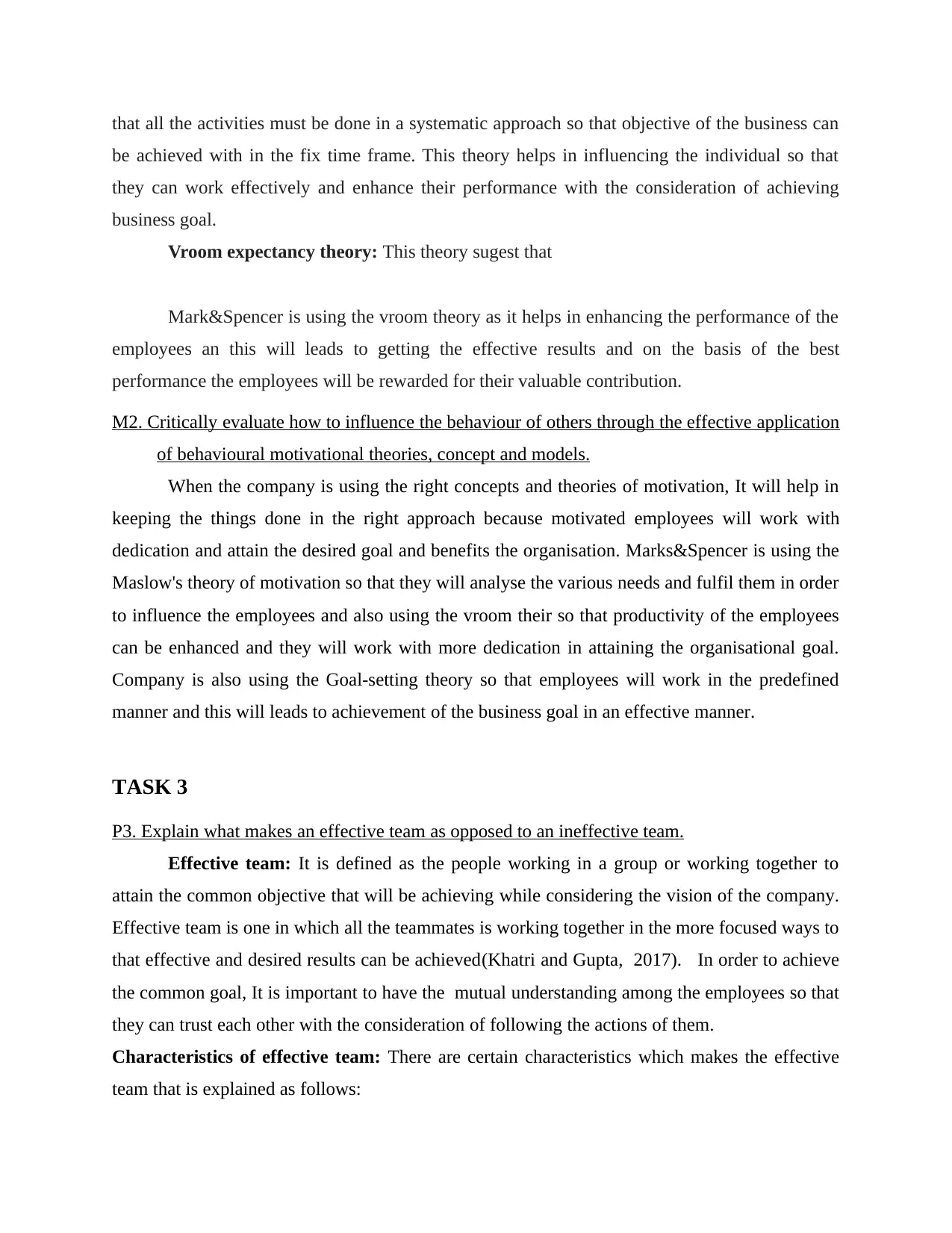
that all the activities must be done in a systematic approach so that objective of the business can
be achieved with in the fix time frame. This theory helps in influencing the individual so that
they can work effectively and enhance their performance with the consideration of achieving
business goal.
Vroom expectancy theory: This theory sugest that
Mark&Spencer is using the vroom theory as it helps in enhancing the performance of the
employees an this will leads to getting the effective results and on the basis of the best
performance the employees will be rewarded for their valuable contribution.
M2. Critically evaluate how to influence the behaviour of others through the effective application
of behavioural motivational theories, concept and models.
When the company is using the right concepts and theories of motivation, It will help in
keeping the things done in the right approach because motivated employees will work with
dedication and attain the desired goal and benefits the organisation. Marks&Spencer is using the
Maslow's theory of motivation so that they will analyse the various needs and fulfil them in order
to influence the employees and also using the vroom their so that productivity of the employees
can be enhanced and they will work with more dedication in attaining the organisational goal.
Company is also using the Goal-setting theory so that employees will work in the predefined
manner and this will leads to achievement of the business goal in an effective manner.
TASK 3
P3. Explain what makes an effective team as opposed to an ineffective team.
Effective team: It is defined as the people working in a group or working together to
attain the common objective that will be achieving while considering the vision of the company.
Effective team is one in which all the teammates is working together in the more focused ways to
that effective and desired results can be achieved(Khatri and Gupta, 2017). In order to achieve
the common goal, It is important to have the mutual understanding among the employees so that
they can trust each other with the consideration of following the actions of them.
Characteristics of effective team: There are certain characteristics which makes the effective
team that is explained as follows:
be achieved with in the fix time frame. This theory helps in influencing the individual so that
they can work effectively and enhance their performance with the consideration of achieving
business goal.
Vroom expectancy theory: This theory sugest that
Mark&Spencer is using the vroom theory as it helps in enhancing the performance of the
employees an this will leads to getting the effective results and on the basis of the best
performance the employees will be rewarded for their valuable contribution.
M2. Critically evaluate how to influence the behaviour of others through the effective application
of behavioural motivational theories, concept and models.
When the company is using the right concepts and theories of motivation, It will help in
keeping the things done in the right approach because motivated employees will work with
dedication and attain the desired goal and benefits the organisation. Marks&Spencer is using the
Maslow's theory of motivation so that they will analyse the various needs and fulfil them in order
to influence the employees and also using the vroom their so that productivity of the employees
can be enhanced and they will work with more dedication in attaining the organisational goal.
Company is also using the Goal-setting theory so that employees will work in the predefined
manner and this will leads to achievement of the business goal in an effective manner.
TASK 3
P3. Explain what makes an effective team as opposed to an ineffective team.
Effective team: It is defined as the people working in a group or working together to
attain the common objective that will be achieving while considering the vision of the company.
Effective team is one in which all the teammates is working together in the more focused ways to
that effective and desired results can be achieved(Khatri and Gupta, 2017). In order to achieve
the common goal, It is important to have the mutual understanding among the employees so that
they can trust each other with the consideration of following the actions of them.
Characteristics of effective team: There are certain characteristics which makes the effective
team that is explained as follows:
⊘ This is a preview!⊘
Do you want full access?
Subscribe today to unlock all pages.

Trusted by 1+ million students worldwide
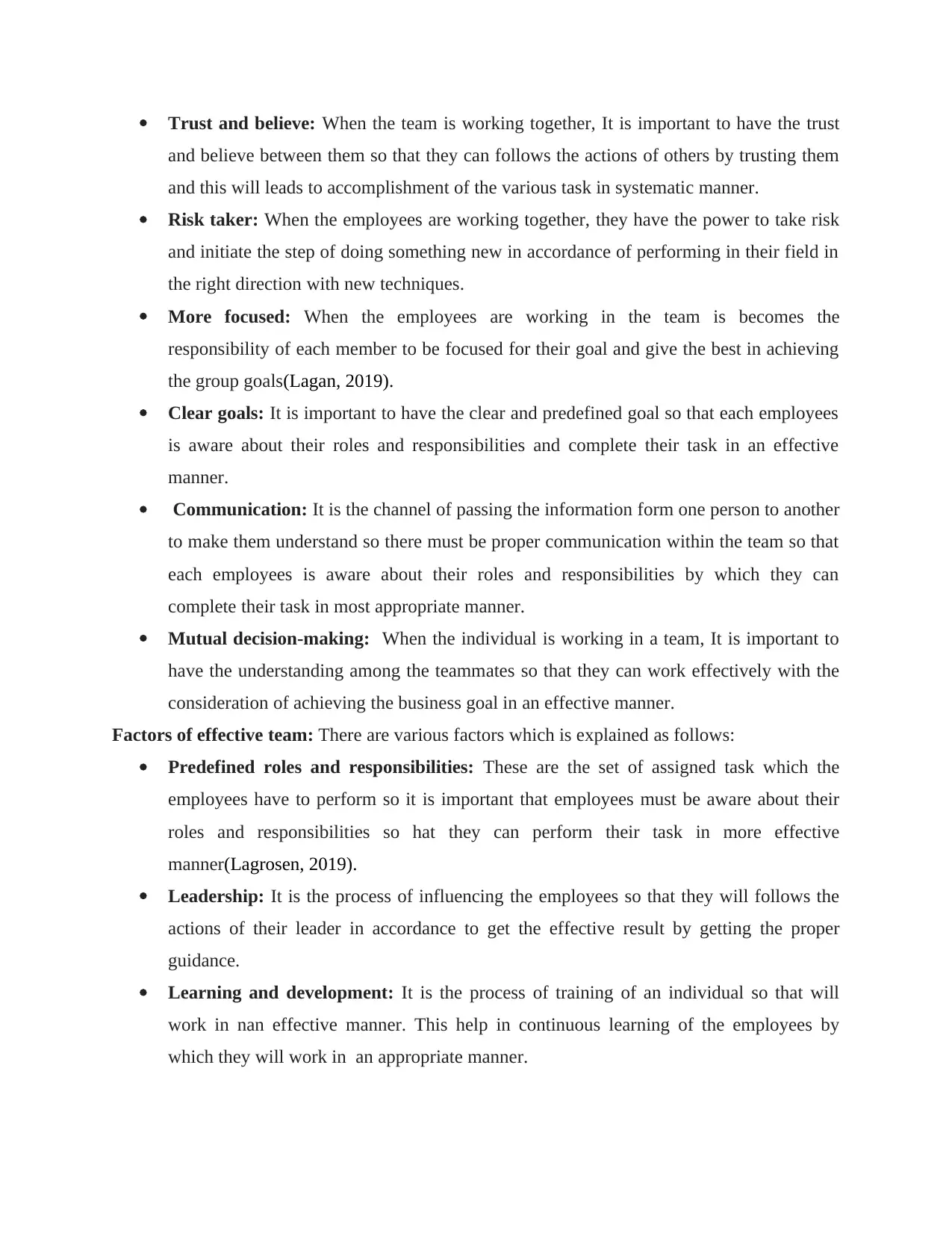
Trust and believe: When the team is working together, It is important to have the trust
and believe between them so that they can follows the actions of others by trusting them
and this will leads to accomplishment of the various task in systematic manner.
Risk taker: When the employees are working together, they have the power to take risk
and initiate the step of doing something new in accordance of performing in their field in
the right direction with new techniques.
More focused: When the employees are working in the team is becomes the
responsibility of each member to be focused for their goal and give the best in achieving
the group goals(Lagan, 2019).
Clear goals: It is important to have the clear and predefined goal so that each employees
is aware about their roles and responsibilities and complete their task in an effective
manner.
Communication: It is the channel of passing the information form one person to another
to make them understand so there must be proper communication within the team so that
each employees is aware about their roles and responsibilities by which they can
complete their task in most appropriate manner.
Mutual decision-making: When the individual is working in a team, It is important to
have the understanding among the teammates so that they can work effectively with the
consideration of achieving the business goal in an effective manner.
Factors of effective team: There are various factors which is explained as follows:
Predefined roles and responsibilities: These are the set of assigned task which the
employees have to perform so it is important that employees must be aware about their
roles and responsibilities so hat they can perform their task in more effective
manner(Lagrosen, 2019).
Leadership: It is the process of influencing the employees so that they will follows the
actions of their leader in accordance to get the effective result by getting the proper
guidance.
Learning and development: It is the process of training of an individual so that will
work in nan effective manner. This help in continuous learning of the employees by
which they will work in an appropriate manner.
and believe between them so that they can follows the actions of others by trusting them
and this will leads to accomplishment of the various task in systematic manner.
Risk taker: When the employees are working together, they have the power to take risk
and initiate the step of doing something new in accordance of performing in their field in
the right direction with new techniques.
More focused: When the employees are working in the team is becomes the
responsibility of each member to be focused for their goal and give the best in achieving
the group goals(Lagan, 2019).
Clear goals: It is important to have the clear and predefined goal so that each employees
is aware about their roles and responsibilities and complete their task in an effective
manner.
Communication: It is the channel of passing the information form one person to another
to make them understand so there must be proper communication within the team so that
each employees is aware about their roles and responsibilities by which they can
complete their task in most appropriate manner.
Mutual decision-making: When the individual is working in a team, It is important to
have the understanding among the teammates so that they can work effectively with the
consideration of achieving the business goal in an effective manner.
Factors of effective team: There are various factors which is explained as follows:
Predefined roles and responsibilities: These are the set of assigned task which the
employees have to perform so it is important that employees must be aware about their
roles and responsibilities so hat they can perform their task in more effective
manner(Lagrosen, 2019).
Leadership: It is the process of influencing the employees so that they will follows the
actions of their leader in accordance to get the effective result by getting the proper
guidance.
Learning and development: It is the process of training of an individual so that will
work in nan effective manner. This help in continuous learning of the employees by
which they will work in an appropriate manner.
Paraphrase This Document
Need a fresh take? Get an instant paraphrase of this document with our AI Paraphraser
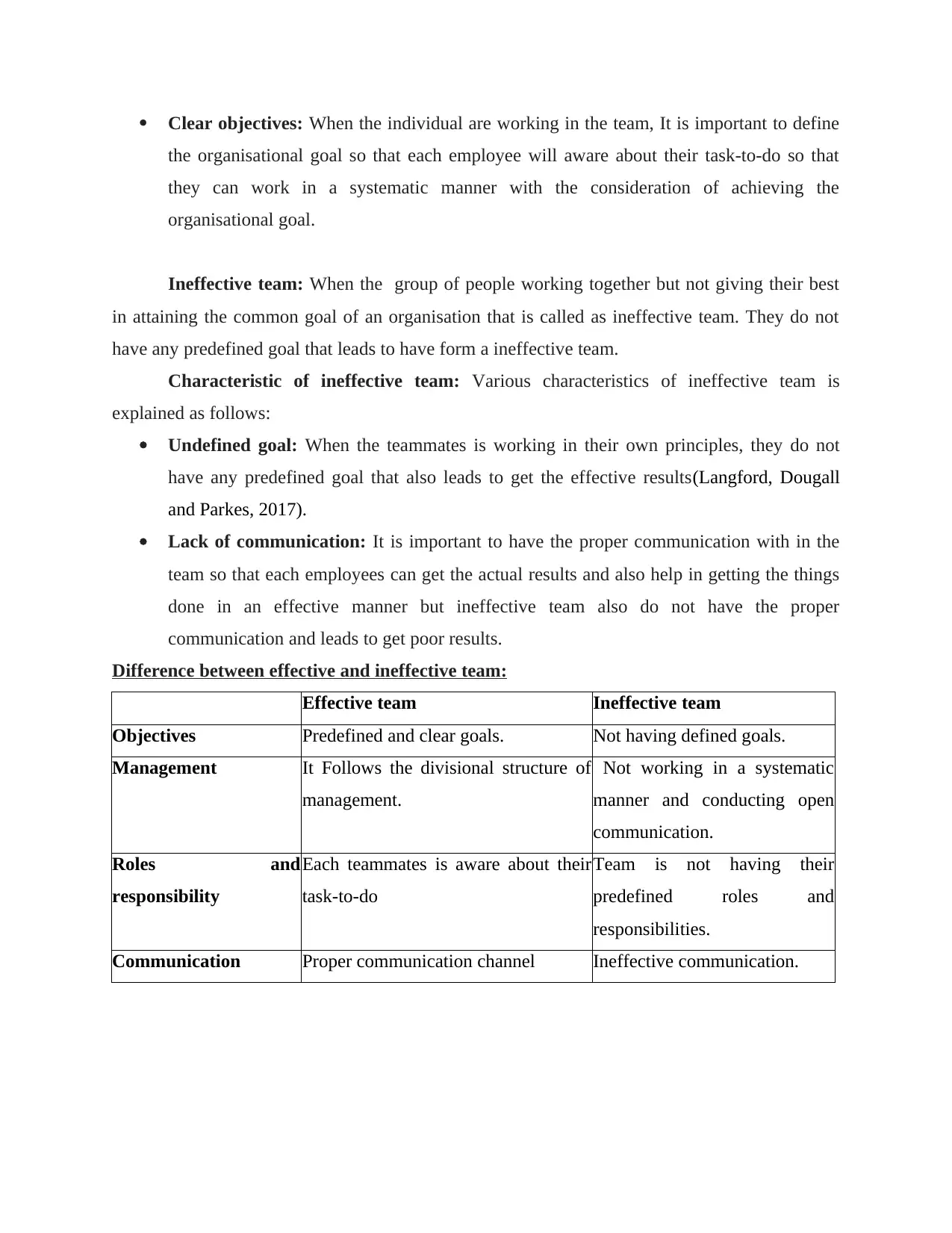
Clear objectives: When the individual are working in the team, It is important to define
the organisational goal so that each employee will aware about their task-to-do so that
they can work in a systematic manner with the consideration of achieving the
organisational goal.
Ineffective team: When the group of people working together but not giving their best
in attaining the common goal of an organisation that is called as ineffective team. They do not
have any predefined goal that leads to have form a ineffective team.
Characteristic of ineffective team: Various characteristics of ineffective team is
explained as follows:
Undefined goal: When the teammates is working in their own principles, they do not
have any predefined goal that also leads to get the effective results(Langford, Dougall
and Parkes, 2017).
Lack of communication: It is important to have the proper communication with in the
team so that each employees can get the actual results and also help in getting the things
done in an effective manner but ineffective team also do not have the proper
communication and leads to get poor results.
Difference between effective and ineffective team:
Effective team Ineffective team
Objectives Predefined and clear goals. Not having defined goals.
Management It Follows the divisional structure of
management.
Not working in a systematic
manner and conducting open
communication.
Roles and
responsibility
Each teammates is aware about their
task-to-do
Team is not having their
predefined roles and
responsibilities.
Communication Proper communication channel Ineffective communication.
the organisational goal so that each employee will aware about their task-to-do so that
they can work in a systematic manner with the consideration of achieving the
organisational goal.
Ineffective team: When the group of people working together but not giving their best
in attaining the common goal of an organisation that is called as ineffective team. They do not
have any predefined goal that leads to have form a ineffective team.
Characteristic of ineffective team: Various characteristics of ineffective team is
explained as follows:
Undefined goal: When the teammates is working in their own principles, they do not
have any predefined goal that also leads to get the effective results(Langford, Dougall
and Parkes, 2017).
Lack of communication: It is important to have the proper communication with in the
team so that each employees can get the actual results and also help in getting the things
done in an effective manner but ineffective team also do not have the proper
communication and leads to get poor results.
Difference between effective and ineffective team:
Effective team Ineffective team
Objectives Predefined and clear goals. Not having defined goals.
Management It Follows the divisional structure of
management.
Not working in a systematic
manner and conducting open
communication.
Roles and
responsibility
Each teammates is aware about their
task-to-do
Team is not having their
predefined roles and
responsibilities.
Communication Proper communication channel Ineffective communication.
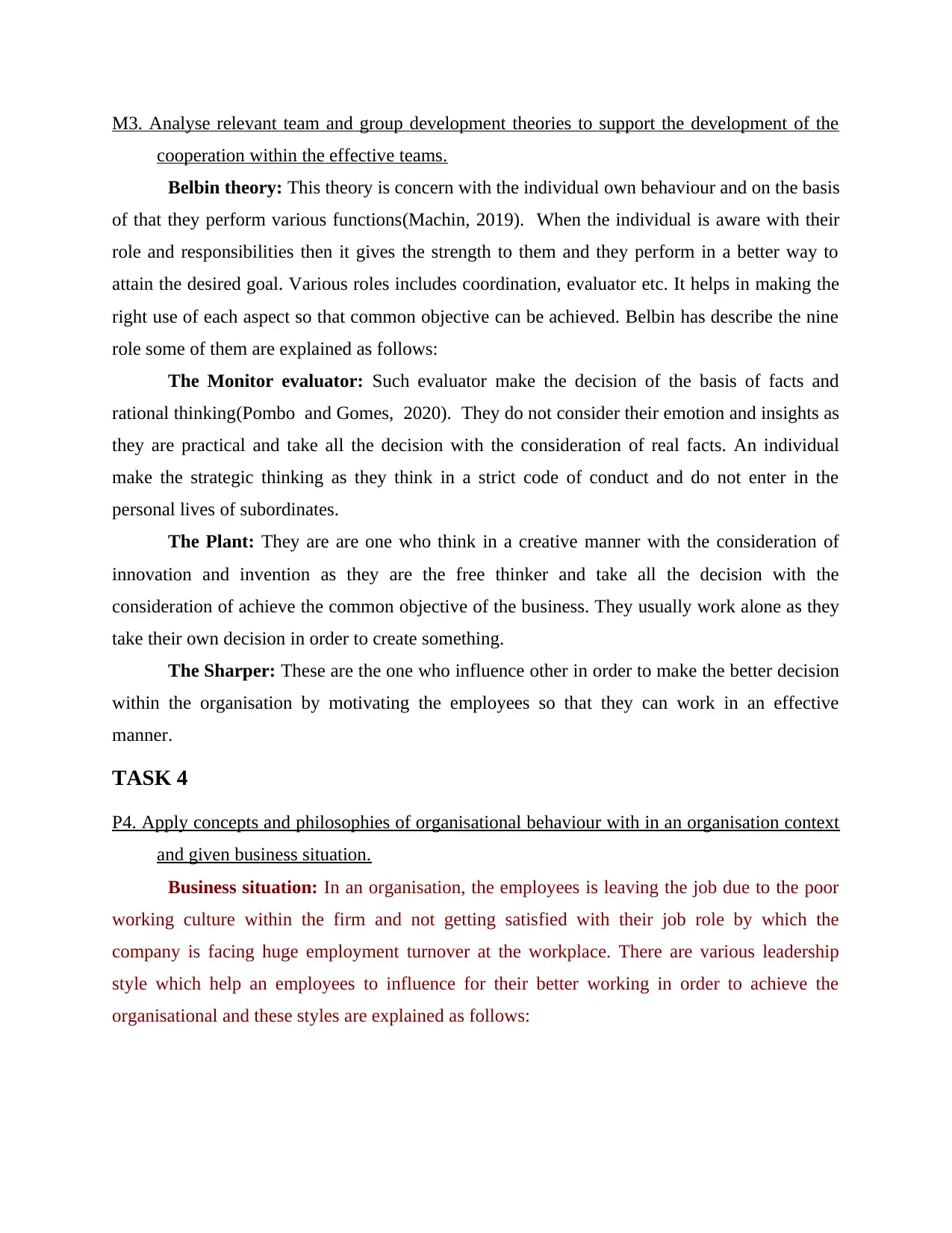
M3. Analyse relevant team and group development theories to support the development of the
cooperation within the effective teams.
Belbin theory: This theory is concern with the individual own behaviour and on the basis
of that they perform various functions(Machin, 2019). When the individual is aware with their
role and responsibilities then it gives the strength to them and they perform in a better way to
attain the desired goal. Various roles includes coordination, evaluator etc. It helps in making the
right use of each aspect so that common objective can be achieved. Belbin has describe the nine
role some of them are explained as follows:
The Monitor evaluator: Such evaluator make the decision of the basis of facts and
rational thinking(Pombo and Gomes, 2020). They do not consider their emotion and insights as
they are practical and take all the decision with the consideration of real facts. An individual
make the strategic thinking as they think in a strict code of conduct and do not enter in the
personal lives of subordinates.
The Plant: They are are one who think in a creative manner with the consideration of
innovation and invention as they are the free thinker and take all the decision with the
consideration of achieve the common objective of the business. They usually work alone as they
take their own decision in order to create something.
The Sharper: These are the one who influence other in order to make the better decision
within the organisation by motivating the employees so that they can work in an effective
manner.
TASK 4
P4. Apply concepts and philosophies of organisational behaviour with in an organisation context
and given business situation.
Business situation: In an organisation, the employees is leaving the job due to the poor
working culture within the firm and not getting satisfied with their job role by which the
company is facing huge employment turnover at the workplace. There are various leadership
style which help an employees to influence for their better working in order to achieve the
organisational and these styles are explained as follows:
cooperation within the effective teams.
Belbin theory: This theory is concern with the individual own behaviour and on the basis
of that they perform various functions(Machin, 2019). When the individual is aware with their
role and responsibilities then it gives the strength to them and they perform in a better way to
attain the desired goal. Various roles includes coordination, evaluator etc. It helps in making the
right use of each aspect so that common objective can be achieved. Belbin has describe the nine
role some of them are explained as follows:
The Monitor evaluator: Such evaluator make the decision of the basis of facts and
rational thinking(Pombo and Gomes, 2020). They do not consider their emotion and insights as
they are practical and take all the decision with the consideration of real facts. An individual
make the strategic thinking as they think in a strict code of conduct and do not enter in the
personal lives of subordinates.
The Plant: They are are one who think in a creative manner with the consideration of
innovation and invention as they are the free thinker and take all the decision with the
consideration of achieve the common objective of the business. They usually work alone as they
take their own decision in order to create something.
The Sharper: These are the one who influence other in order to make the better decision
within the organisation by motivating the employees so that they can work in an effective
manner.
TASK 4
P4. Apply concepts and philosophies of organisational behaviour with in an organisation context
and given business situation.
Business situation: In an organisation, the employees is leaving the job due to the poor
working culture within the firm and not getting satisfied with their job role by which the
company is facing huge employment turnover at the workplace. There are various leadership
style which help an employees to influence for their better working in order to achieve the
organisational and these styles are explained as follows:
⊘ This is a preview!⊘
Do you want full access?
Subscribe today to unlock all pages.

Trusted by 1+ million students worldwide
1 out of 17
Related Documents
Your All-in-One AI-Powered Toolkit for Academic Success.
+13062052269
info@desklib.com
Available 24*7 on WhatsApp / Email
![[object Object]](/_next/static/media/star-bottom.7253800d.svg)
Unlock your academic potential
Copyright © 2020–2025 A2Z Services. All Rights Reserved. Developed and managed by ZUCOL.



